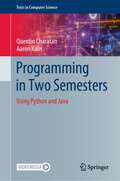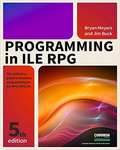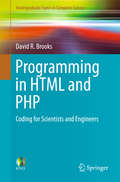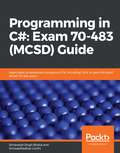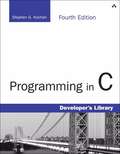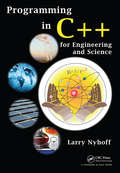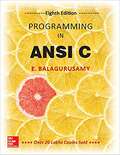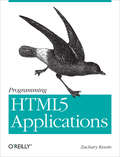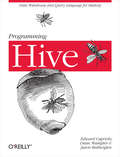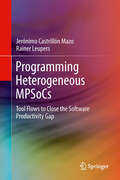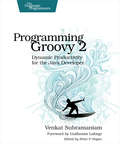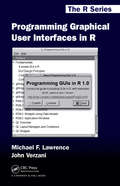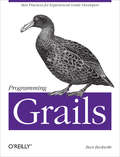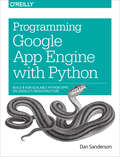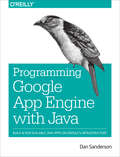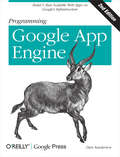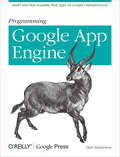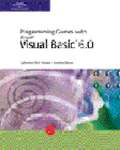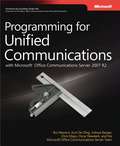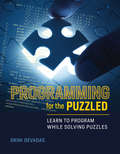- Table View
- List View
Programming in Two Semesters: Using Python and Java (Texts in Computer Science)
by Quentin Charatan Aaron KansThis highly accessible textbook teaches programming from first principles. In common with many programming courses, it uses Python as the introductory programming language before going on to use Java as the vehicle for more advanced programming concepts. The first part, which teaches Python, covers fundamental programming concepts, such as data types and control structures and functions. It introduces more complex data types such as lists and dictionaries and also deals with file handling. It introduces object-oriented concepts and ends with a case study bringing together all the topics of the first semester. The second part uses Java to teach advanced concepts and centres around object-oriented programming, teaching key object-oriented concepts such as inheritance and polymorphism. The semester again ends with an advanced case study bringing together all the topics of the second semester. Topics and features: Assumes no prior knowledge, and makes the transition from Python to Java a smooth process Features numerous exercises and also an illustrative case study for each language Examines procedural and object-oriented methodologies, as well as design principles Covers such advanced topics as interfaces and lambda expressions, exceptions and Collections Includes a chapter on graphics programming in Python using Tkinter Introduces the latest Java technology for graphical interfaces, JavaFX Explains design concepts using UML notation Offering a gentle introduction to the field and assuming no prerequisite background, Programming in Two Semesters is the ideal companion to undergraduate modules in software development or programming. In addition, it will serve as a strong primer for professionals looking to strengthen their knowledge of programming with these languages.
Programming in ILE RPG, Fifth Edition
by Bryan Meyers Jim BuckSince its original publication, Programming in RPG IV has given thousands of students and professionals a strong foundation in the essentials of business programming using RPG IV. Now, the long-awaited Fifth Edition, retitled Programming in ILE RPG, produces the most significant update to this "gold standard" book in many years. The book has been reorganized and updated to the newest software release. It includes exclusive coverage of free-format RPG, new attention to SQL, and expanded emphasis on ILE modules, procedures, and service programs. All-new programming exercises and assignments add even more value for learning. The book includes complete coverage of the program development process, the newest development tools, RPG IV instructions and operations, creating and using files, program workflow and structured design, arithmetic operations and functions, accessing and updating database files, writing interactive applications, modular programming, service programs, error handling, subfiles, APIs, and more. This book is the one guide you need to learn how to be successful with all aspects of ILE RPG.
Programming in HTML and PHP
by David R. BrooksThis concise and accessible textbook will enable readers to quickly develop the working skills necessary to solve computational problems in a server-based environment, using HTML and PHP. The importance of learning by example (as opposed to simply learning by copying) is emphasized through extensive use of hands-on exercises and examples, with a specific focus on useful science and engineering applications. The clearly-written text is designed to be simple to follow for the novice student, without requiring any background in programming or mathematics beyond algebra. Topics and features: describes the creation of HTML pages and the characteristics of HTML documents, showing how to use HTML tables, forms, lists, and frames to organize documents for use with PHP applications; explains how to set up a PHP environment, using a local or remote server; introduces the capabilities and syntax of the PHP language, including coverage of array syntax and use; examines user-defined functions in programming, summarizing PHP functions for reading and writing files, viewing the content of variables, and manipulating strings; reviews the PHP GD graphics library, presenting applications for creating pie charts, bar graphs, and line graphs suitable for displaying scientific data; includes appendices listing HTML and ASCII special characters, and highlighting the essential basic strategies for solving computational problems. Supplying all of the tools necessary to begin coding in HTML and PHP, this invaluable textbook is ideal for undergraduate students taking introductory courses in programming. The book will also serve as a helpful self-study text for professionals in any technical field.
Programming in Haskell
by Graham HuttonHaskell is a purely functional language that allows programmers to rapidly develop clear, concise, and correct software. The language has grown in popularity in recent years, both in teaching and in industry. This book is based on the author's experience of teaching Haskell for more than twenty years. All concepts are explained from first principles and no programming experience is required, making this book accessible to a broad spectrum of readers. While Part I focuses on basic concepts, Part II introduces the reader to more advanced topics. This new edition has been extensively updated and expanded to include recent and more advanced features of Haskell, new examples and exercises, selected solutions, and freely downloadable lecture slides and example code. The presentation is clean and simple, while also being fully compliant with the latest version of the language, including recent changes concerning applicative, monadic, foldable, and traversable types. This new edition has been extensively revised and expanded, including four new chapters as well as many new examples and exercises. Fully compliant with the latest version of Haskell, and updated to include more recent features. An accompanying website provides a range of supporting materials, including PowerPoint slides and Haskell code for the extended examples. <P><P><i>Advisory: Bookshare has learned that this book offers only partial accessibility. We have kept it in the collection because it is useful for some of our members. To explore further access options with us, please contact us through the Book Quality link on the right sidebar. Benetech is actively working on projects to improve accessibility issues such as these.</i>
Programming in Haskell
by Graham HuttonHaskell is a purely functional language that allows programmers to rapidly develop clear, concise, and correct software. The language has grown in popularity in recent years, both in teaching and in industry. This book is based on the author's experience of teaching Haskell for more than twenty years. All concepts are explained from first principles and no programming experience is required, making this book accessible to a broad spectrum of readers. While Part I focuses on basic concepts, Part II introduces the reader to more advanced topics. This new edition has been extensively updated and expanded to include recent and more advanced features of Haskell, new examples and exercises, selected solutions, and freely downloadable lecture slides and example code. The presentation is clean and simple, while also being fully compliant with the latest version of the language, including recent changes concerning applicative, monadic, foldable, and traversable types.
Programming in Haskell
by Graham HuttonHaskell is one of the leading languages for teaching functional programming, enabling students to write simpler and cleaner code, and to learn how to structure and reason about programs. This introduction is ideal for beginners: it requires no previous programming experience and all concepts are explained from first principles via carefully chosen examples. Each chapter includes exercises that range from the straightforward to extended projects, plus suggestions for further reading on more advanced topics. The author is a leading Haskell researcher and instructor, well-known for his teaching skills. The presentation is clear and simple, and benefits from having been refined and class-tested over several years. The result is a text that can be used with courses, or for self-learning. Features include: freely accessible powerpoint slides for each chapter; solutions to exercises, and examination questions (with solutions) available to instructors; downloadable code that's fully compliant with the latest Haskell release.
Programming in C# (MCSD) Guide: Learn basic to advanced concepts of C#, including C# 8, to pass Microsoft MCSD 70-483 exam
by Simaranjit Singh BhallaThe book is intended to the aspirants of Microsoft certifications and C# developers wanting to become a Microsoft specialist. The book assumes C# knowledge and promises to take it to a practical level.
Programming In C (Fourth Edition)
by Stephen G. KochanProgramming in C will teach you how to write programs in the C programming language. Whether you're a novice or experienced programmer, this book will provide you with a clear understanding of this language, which is the foundation for many object-oriented programming languages such as C++, Objective-C, C#, and Java. <P><P> This book teaches C by example, with complete C programs used to illustrate each new concept along the way. Stephen Kochan provides step-by-step explanations for all C functions. You will learn both the language fundamentals and good programming practices. Exercises at the end of each chapter make the book ideally suited for classroom use or for self-instruction. <P><P> All the features of the C language are covered in this book, including the latest additions added with the C11 standard. Appendixes provide a detailed summary of the language and the standard C library, both organized for quick reference.
Programming in C++ for Engineering and Science
by Larry NyhoffDeveloped from the author's many years of teaching computing courses, Programming in C++ for Engineering and Science guides students in designing programs to solve real problems encountered in engineering and scientific applications. These problems include radioactive decay, pollution indexes, digital circuits, differential equations, Internet addr
Programming in ANSI C
by E. BalagurusamyAccessible textbook of Programming in ANSI C, eighth edition by E. Balagurusamy. A text book with theoretical and practical approach to learning ANSI C programming with examples and exercises. It contains concepts from elementary to advanced level programming covering critical concepts, such as Arrays, Strings, Functions, Pointers, Self-referential Structures, Dynamic Memory Allocation, etc. which makes this book a great reference guide for the beginners as well as advanced learners.
Programming in Ada 2012
by John BarnesAda 2012 is the latest version of the international standard for the programming language Ada. It is designated ISO/IEC 8652:2012 (E) and is a new edition replacing the 2005 version. The primary goals for the new version were to further enhance its capabilities particularly in those areas where its reliability and predictability are of great value. Many important new features have been included such as those defining dynamic contracts and for handling multiprocessors and are integrated within the existing language framework in an elegant and coherent manner. The Ada 2012 Rationale describes not only the changes from Ada 2005 but also the reason for the changes. It starts with an introduction providing a general overview and this is followed by seven chapters focusing on contracts and aspects; extended expressions; structure and visibility; tasking and real time; iterators and pools; predefined library and containers. The book concludes with an epilogue largely concerned with compatibility issues.
Programming HTML5 Applications: Building Powerful Cross-Platform Environments in JavaScript
by Zachary Kessin<p>With this digital <b>Early Release</b> edition of <i>Programming HTML5 Applications</i>, you get the entire book bundle in its earliest form – the author's raw and unedited content – so you can take advantage of this content long before the book's official release. You'll also receive updates when significant changes are made, as well as the final ebook version. <br/><br/>\nMove beyond simple site creation and build web applications with HTML5 that can compete with desktop apps and run on mobile devices. This practical guide shows you how HTML5's JavaScript APIs give you the power to take web development into many fields that used to require more platform-specific development—particularly mobile deployment. You’ll also learn many ways to make application development with JavaScript more powerful.</p>
Programming Hive: Data Warehouse and Query Language for Hadoop (Oreilly And Associate Ser.)
by Jason Rutherglen Edward Capriolo Dean Wampler<p>This comprehensive guide introduces you to Apache Hive, Hadoop’s data warehouse infrastructure. You’ll quickly learn how to use Hive’s SQL dialect—HiveQL—to summarize, query, and analyze large datasets stored in Hadoop’s distributed filesystem. This example-driven guide shows you how to set up and configure Hive in your environment, provides a detailed overview of Hadoop and MapReduce, and demonstrates how Hive works within the Hadoop ecosystem.</p>
Programming Heterogeneous MPSoCs
by Jerónimo Castrillón Mazo Rainer LeupersThis book provides embedded software developers with techniques for programming heterogeneous Multi-Processor Systems-on-Chip (MPSoCs), capable of executing multiple applications simultaneously. It describes a set of algorithms and methodologies to narrow the software productivity gap, as well as an in-depth description of the underlying problems and challenges of today's programming practices. The authors present four different tool flows: A parallelism extraction flow for applications written using the C programming language, a mapping and scheduling flow for parallel applications, a special mapping flow for baseband applications in the context of Software Defined Radio (SDR) and a final flow for analyzing multiple applications at design time. The tool flows are evaluated on Virtual Platforms (VPs), which mimic different characteristics of state-of-the-art heterogeneous MPSoCs.
Programming Groovy 2: Dynamic Productivity for the Java Developer
by Venkat SubramaniamGroovy brings you the best of both worlds: a flexible, highly productive, agile, dynamic language that runs on the rich framework of the Java Platform. Groovy preserves the Java semantics and extends the JDK to give you true dynamic language capabilities. Programming Groovy 2 will help you, the experienced Java developer, learn and take advantage of the latest version of this rich dynamic language. You'll go from the basics of Groovy to the latest advances in the language, including options for type checking, tail-call and memoization optimizations, compile time metaprogramming, and fluent interfaces to create DSLs. You don't have to leave the rich Java Platform to take advantage of Groovy. Groovy preserves Java's semantics and extends the JDK, so programming in Groovy feels like the Java language has been augmented; it's like working with a lighter, more elegant Java. If you're an experienced Java developer who wants to learn how Groovy works, you'll find exactly what you need in this book.You'll start with the fundamentals of programming in Groovy and how it works with Java, and then you'll explore advanced concepts such as unit testing with mock objects, using Builders, working with databases and XML, and creating DSLs. You'll master Groovy's powerful yet complex run-time and compile-time metaprogramming features.Much has evolved in the Groovy language since the publication of the first edition of Programming Groovy. Programming Groovy 2 will help you learn and apply Groovy's new features. Creating DSLs is easier now, and Groovy's already-powerful metaprogramming facilities have improved even more. You'll see how to work with closures, including tail call optimization and memoization. The book also covers Groovy's new static compilation feature.Whether you're learning the basics of the language or interested in getting proficient with the new features, Programming Groovy 2 has you covered.What You NeedTo work on the examples in the book you need Groovy 2.0.5 and Java JDK 5 or higher.
Programming Graphical User Interfaces in R (Chapman & Hall/CRC The R Series #5)
by Michael Lawrence John VerzaniProgramming Graphical User Interfaces with R introduces each of the major R packages for GUI programming: RGtk2, qtbase, Tcl/Tk, and gWidgets. With examples woven through the text as well as stand-alone demonstrations of simple yet reasonably complete applications, the book features topics especially relevant to statisticians who aim to provide a practical interface to functionality implemented in R. The book offers: A how-to guide for developing GUIs within R The fundamentals for users with limited knowledge of programming within R and other languages GUI design for specific functions or as learning tools The accompanying package, ProgGUIinR, includes the complete code for all examples as well as functions for browsing the examples from the respective chapters. Accessible to seasoned, novice, and occasional R users, this book shows that for many purposes, adding a graphical interface to one’s work is not terribly sophisticated or time consuming.
Programming Grails: Best Practices for Experienced Grails Developers
by Burt BeckwithResponding to the demand for more in-depth Grails coverage that goes beyond the typical use cases, this book helps experienced developers understand the motivation behind the core ideas of this web development framework. You'll learn Grails best practices for building and deployment, debugging and problem solving, creating and using Grails plugins, as well as testing, security, performance, scaling, tuning, and monitoring. In the process, you'll focus on technologies that Grails uses and integrates with, including: Spring, Hibernate, and relational and non-relational (NoSQL) alternatives to Hibernate Java Enterprise Edition technologies such as EJBs, JMS, and JNDI REST, SOAP, Spring Integration, and Apache Camel
Programming Google App Engine with Python
by Dan SandersonThis practical guide shows intermediate and advanced web and mobile app developers how to build highly scalable Python applications in the cloud with Google App Engine. The flagship of Google's Cloud Platform, App Engine hosts your app on infrastructure that grows automatically with your traffic, minimizing up-front costs and accommodating unexpected visitors. You'll learn hands-on how to perform common development tasks with App Engine services and development tools, including deployment and maintenance.App Engine's Python support includes a fast Python 2.7 interpreter, the standard library, and a WSGI-based runtime environment. Choose from many popular web application frameworks, including Django and Flask.Get a hands-on introduction to App Engine's tools and features, using an example applicationSimulate App Engine on your development machine with tools from Google Cloud SDKStructure your app into individually addressable modules, each with its own scaling configurationExploit the power of the scalable Cloud Datastore, using queries, transactions, and data modeling with the ndb libraryUse Cloud SQL for standard relational databases with App Engine applicationsLearn how to deploy, manage, and inspect your application on Google infrastructure
Programming Google App Engine with Java
by Dan SandersonThis practical guide shows intermediate and advanced web and mobile app developers how to build highly scalable Java applications in the cloud with Google App Engine. The flagship of Google's Cloud Platform, App Engine hosts your app on infrastructure that grows automatically with your traffic, minimizing up-front costs and accommodating unexpected visitors. You'll learn hands-on how to perform common development tasks with App Engine services and development tools, including deployment and maintenance.For Java applications, App Engine provides a J2EE standard servlet container with a complete Java 7 JVM and standard library. Because App Engine supports common Java API standards, your code stays clean and portable.Get a hands-on introduction to App Engine's tools and features, using an example applicationSimulate App Engine on your development machine directly from EclipseStructure your app into individually addressable modules, each with its own scaling configurationExploit the power of the scalable Cloud Datastore, using queries, transactions, and data modeling with JPAUse Cloud SQL for standard relational databases with App Engine applicationsLearn how to deploy, manage, and inspect your application on Google infrastructure
Programming Google App Engine: Build & Run Scalable Web Applications on Google's Infrastructure (Animal Guide Ser.)
by Dan Sanderson<p>With this digital <b>Early Release</b> edition of <i>Programming Google App Engine</i>, you get the entire book bundle in its earliest form – the author's raw and unedited content – so you can take advantage of this content long before the book's official release. You'll also receive updates when significant changes are made, as well as the final ebook version.\nGoogle App Engine does more than provide access to a large system of servers. It also offers you a simple model for building applications that scale automatically to accommodate millions of users. With this updated edition of <i>Programming Google App Engine</i>, you'll get expert practical guidance that will help you make the best use of this powerful platform. Google engineer Dan Sanderson shows you how to design your applications for scalability, including ways to perform common development tasks using App Engine's APIs and scalable services.</p>
Programming Google App Engine: Build and Run Scalable Web Apps on Google's Infrastructure (Animal Guide)
by Dan SandersonAs one of today's cloud computing services, Google App Engine does more than provide access to a large system of servers. It also offers you a simple model for building applications that scale automatically to accommodate millions of users. With Programming Google App Engine, you'll get expert practical guidance that will help you make the best use of this powerful platform. Google engineer Dan Sanderson shows you how to design your applications for scalability, including ways to perform common development tasks using App Engine's APIs and scalable services. You'll learn about App Engine's application server architecture, runtime environments, and scalable datastore for distributing data, as well as techniques for optimizing your application. App Engine offers nearly unlimited computing power, and this book provides clear and concise instructions for getting the most from it right from the source. Discover the differences between traditional web development and development with App EngineLearn the details of App Engine's Python and Java runtime environmentsUnderstand how App Engine handles web requests and executes application codeLearn how to use App Engine's scalable datastore, including queries and indexes, transactions, and data modelingUse task queues to parallelize and distribute work across the infrastructureDeploy and manage applications with ease
Programming Games With Microsoft Visual Basic 6.0
by Catherine Muir Dwyer Jeanine MeyerStudents will learn important programming concepts while creating fun thought-provoking games like Minesweeper, Hangman, and Memory.
Programming for Unified Communications with Microsoft® Office Communications Server 2007 R2
by Chris Mayo Kurt De Ding Oscar Newkerk Rui Maximo Vishwa RanjanDirect from the Microsoft Office Communications Server product team, get the hands-on guidance you need to streamline your organization's real-time, remote communication and collaboration solutions across the enterprise and across time zones.
Programming for Unified Communications with Microsoft® Office Communications Server 2007 R2
by Chris Mayo Kurt De Ding Oscar Newkerk Rui Maximo Vishwa Ranjan Microsoft Communications Server TeamExploit the Unified Communications (UC) platform's rich and open API set--and create your own real-time communication solutions faster. Led by a team of UC programming experts, you'll get the code walkthroughs and pragmatic advice you need to seamlessly integrate enterprise IM, presence, VoIP, and conferencing into your applications now. Connect users exactly how and when they want--and increase business agility Examine the architecture, design model, and scenarios for each API--matching the right functionality to your needs Automate Office Communicator features--sign-in, contacts, presence, conversations Use contextual collaboration to send and receive application-specific messages between clients Develop Windows Workflow applications that support both voice and IM Create and provision custom presence applications Build server-side applications that maximize throughput and enable multiparty conferencing Prepare your application for deployment Apply best practices for debugging and troubleshootingProgramming for Unified Communications with Microsoft® Office Communications Server 2007 R2
Programming for the Puzzled: Learn to Program While Solving Puzzles (The\mit Press Ser.)
by Srini DevadasLearning programming with one of “the coolest applications around”: algorithmic puzzles ranging from scheduling selfie time to verifying the six degrees of separation hypothesis.This book builds a bridge between the recreational world of algorithmic puzzles (puzzles that can be solved by algorithms) and the pragmatic world of computer programming, teaching readers to program while solving puzzles. Few introductory students want to program for programming's sake. Puzzles are real-world applications that are attention grabbing, intriguing, and easy to describe. Each lesson starts with the description of a puzzle. After a failed attempt or two at solving the puzzle, the reader arrives at an Aha! moment—a search strategy, data structure, or mathematical fact—and the solution presents itself. The solution to the puzzle becomes the specification of the code to be written. Readers will thus know what the code is supposed to do before seeing the code itself. This represents a pedagogical philosophy that decouples understanding the functionality of the code from understanding programming language syntax and semantics. Python syntax and semantics required to understand the code are explained as needed for each puzzle.Readers need only the rudimentary grasp of programming concepts that can be obtained from introductory or AP computer science classes in high school. The book includes more than twenty puzzles and more than seventy programming exercises that vary in difficulty. Many of the puzzles are well known and have appeared in publications and on websites in many variations. They range from scheduling selfie time with celebrities to solving Sudoku problems in seconds to verifying the six degrees of separation hypothesis. The code for selected puzzle solutions is downloadable from the book's website; the code for all puzzle solutions is available to instructors.
